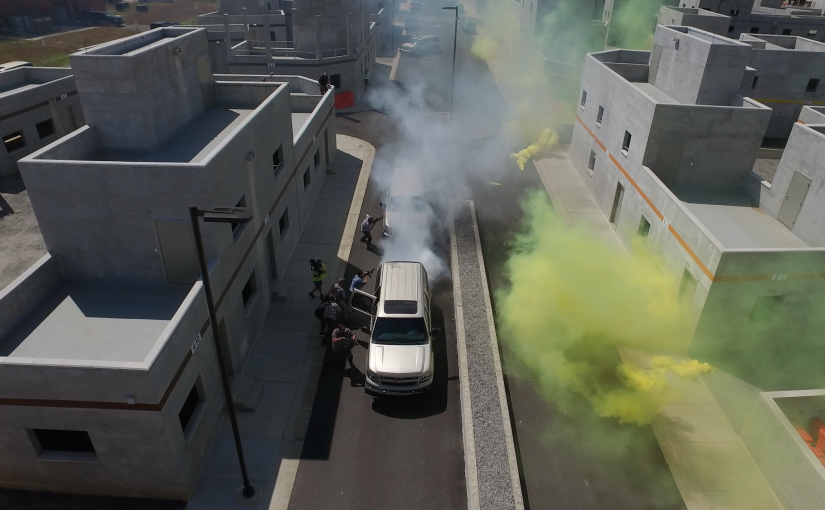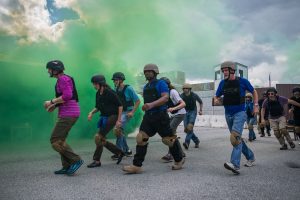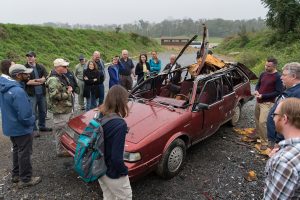In a dark, smoke-filled room and stairway—also known as a “smokehouse” in training lingo—a Diplomatic Security Service (DSS) special agent safely evacuates others, thus experiencing the sensations of evacuating a building in fire-compromised conditions. The agent immediately administers first aid at the scene for injured embassy personnel and coordinates the evacuation of wounded onto a waiting helicopter.
Nearby, on a high-speed track, a special agent drives an armored SUV through a controlled skid on a rain-slick patch of road, successfully maneuvering through a potentially fatal loss of control. The special agent then encounters a roadblock at high speed and threshold brakes. The special agent shifts into reverse and accelerates away before safely conducting a Y–turn, avoiding what could have been an armed ambush in a hostile country overseas.
These two scenarios are examples of the types of exercises already underway at the U.S. Department of State’s Foreign Affairs Security Training Center (FASTC), which formally opened in an inauguration ceremony on November 14, 2019. FASTC is a new consolidated hard-skills training facility located in the sleepy foothills of rural Virginia near the small town of Blackstone. A visitor might see a mock embassy compound, high-speed driving tracks, an explosives range, and a live-fire shoot house—and those sights are only a few of the visible components of FASTC.
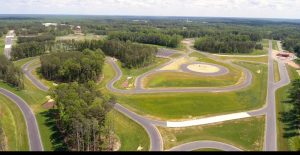
Located on 1,350 acres of the 55,000-acre training complex at Fort Pickett, a Virginia Army National Guard installation, FASTC is designed to help meet the U.S. Department of State’s growing security training needs and the threats the foreign affairs community faces overseas. Managed by the U.S. Department of State’s Diplomatic Security Service (DSS), the law enforcement and security arm of the Department of State, FASTC is a comprehensive complex that allows DSS to provide and conduct integrated training in a way that has never been done before for the foreign affairs community.
In addition to its law enforcement duties of investigating passport and visa fraud and related crimes, DSS enables a safe environment for the conduct of U.S. diplomacy—protecting people, property, and information at U.S. missions throughout the world. What distinguishes DSS from other law enforcement organizations is its global reach and presence, which far exceeds that of any other federal agency. More than 2,000 DSS special agents, security engineers and technicians, and diplomatic couriers serve in 29 domestic offices across the United States and 275 U.S. embassies and consulates in 170 countries across the globe.
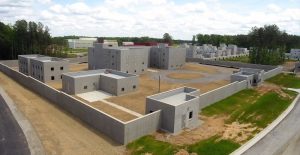
The new FASTC facility is specifically designed for the unique challenges of securing diplomacy in a challenging, global environment. FASTC provides hard-skills security training to DSS special agents and other security personnel, but it also helps other Department of State personnel and the foreign affairs community learn how to stay safe as they carry out U.S. diplomatic duties abroad. Some of the skills DSS teaches at FASTC include detecting surveillance, providing emergency medical care, recognizing improvised explosive devices, participating in firearms familiarization, and performing defensive and counterterrorism driving maneuvers.
At FASTC, instructors can simultaneously carry out multiple training exercises. The campus includes three high-speed driving tracks, off-road and improved tracks, explosives ranges, tactical structures to simulate risk of serious injury or death situations, and two smokehouses for situations when fire is used as a weapon. Training also includes land navigation, capstone exercises, and scenarios involving a mock embassy compound.
A Long Time in the Making
The Department of State identified the need for a more efficient, consolidated training facility for security personnel as early as the mid-1990s. In past years, existing hard-skills training for DSS had taken place in as many as 11 different sites scattered across the eastern United States, resulting in a dependency on contract facilities, extensive travel and other related costs, and disparate, disjointed training exercises.
This need was underscored in the wake of the August 1998 bombings of the U.S. embassies in Nairobi, Kenya, and Dar es Salaam, Tanzania, and took on a greater sense of urgency following the 9/11 terrorist attacks in 2001 and the subsequent deployment of U.S. forces into Afghanistan and Iraq. After the 2012 attack on the U.S. Special Mission Compound in Benghazi, Libya, the independent Accountability Review Board (ARB) report on Benghazi reinforced the need to improve and expand U.S. security training as a key goal for improving the department’s training.
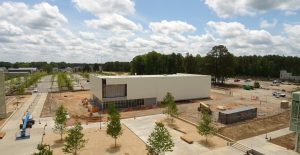
Based on requirements and site review, DSS assessed that 90 percent of the training needs required newly constructed or modified facilities at the existing properties. Those deficiencies further drove home the fact that a separate training facility for DSS was needed.
After reviewing more than 70 properties, the Department of State and General Services Administration announced in April 2014 that Fort Pickett in Blackstone, Virginia, would be the location for the new FASTC facility, which would be designed to provide elite security training to U.S. government personnel assigned to posts around the world. The facility’s close proximity to the Department of State’s headquarters in Washington, DC, also provided FASTC personnel with opportunities to collaborate with key partners in the special operations community, along with the mid-Atlantic region’s law enforcement officers.
U.S. Federal Security and Antiterrorism Training
In April 2016, after months of planning, construction began on FASTC, one of the largest federal security and antiterrorism enforcement training facilities in the United States. Although training DSS special agents is a key component of its mission, FASTC goes far beyond law enforcement training—supporting the entire foreign affairs community. In fact, roughly two-thirds of annual throughput will be Foreign Affairs Counter Threat (FACT) training required of all Department of State and other federal agency personnel under the security responsibility of the Secretary of State.

Constructed in three phases, FASTC hard skills training sites include a rappel tower, a tactical maze, two smokehouses, an explosive demo range, a live-fire shoot house, a mock embassy, a tactical training building, an unimproved road track for driving over non-paved or rugged terrain, a post-blast training range, two high-speed anti-terrorism driving tracks, an explosive simulation alley, a mock urban driving track, indoor and outdoor firing ranges, and an additional driving track. The facility also includes an administrative building, a vehicle maintenance shop, a state-of-the art fitness center with a cafe, and classroom buildings.
Security Training and Diplomacy Go Hand-in-Hand
The continually changing demands of a complex and dangerous global environment drive the Department of State’s unconventional and extensive security training requirements. For example, training on how to deal with fire and smoke as potential weapons against diplomats serving overseas is an outgrowth of the 2012 attack in Benghazi where fire and smoke in a hostile environment led to the deaths of four U.S. personnel. Also, because of the wide variety of overseas terrain and safety challenges, DSS requires access to the type of heavy and specialized weapon ranges typically employed by its Department of Defense partners.
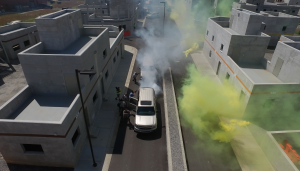
In addition, given Marine Security Guards’ (MSG) important role in embassy security overseas, the Department of State works closely with the Marine Corps Embassy Security Group (MCESG). Based in Quantico, Virginia, near FASTC, the MCESG oversees both the MSG program and the Marine Security Augmentation Unit (MSAU), a special purpose unit deployed to reinforce embassy security during high- and critical-threat periods.
Because of this close proximity to military facilities, FASTC gives DSS and other Department of State personnel opportunities to train alongside Department of Defense counterparts and also provides access to Fort Pickett’s military airfield, capable of supporting unmanned aerial vehicles and rotary and fixed wing aircraft, as well as multiple helicopter landing zones.
Training Saves Lives Overseas
Fire as a Weapon: One of the New Security Challenges Overseas |
|
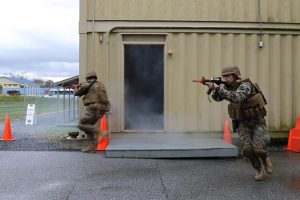 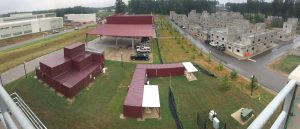
Fire-as-a-weapon response is one of many hard-skills training that is consolidated in a single location at FASTC in Blackstone, Virginia. Participants are trained how to react, plan, and defend during a fire emergency that is a direct result of an enemy attack. Fire is an easily accessible and deployable weapon that has been used by U.S. adversaries to harm people inside buildings and as a way to force people out of buildings to be attacked as they exit. |
Security-related training is essential to ensure the safety of U.S. foreign affairs personnel and others overseas. The following are examples of how training has helped save lives in locations a world away from the United States:
Kabul, Afghanistan. On September 26, 2016, a fire broke out in a housing unit on Camp Sullivan, a U.S. Embassy compound in Kabul, Afghanistan. Responders used fire extinguishers to put out the blaze. There were no major injuries reported, and damage was minor. The DSS personnel who responded credited their Fire as a Weapon course during high-threat training in helping them to move in choking smoke, enhancing their confidence, and providing the knowledge to take control of the situation.
Port-au-Prince, Haiti. On February 6, 2016, a USAID employee and five colleagues were attacked by armed assailants while driving in Port-au-Prince, Haiti. Two personnel in the front seats were graduates of FACT training; they made quick decisions based on the security training and took immediate and effective action. After multiple shots were fired at the vehicle, the driver, using driving techniques taught during the FACT course, maintained control of the vehicle and did not freeze under fire. All personnel departed the area without sustaining injury.
Tripoli, Libya. In 2014, the Department of State was forced to evacuate its personnel because of violence resulting from clashes between Libyan militias nearby. DSS special agents, who had been trained in high-threat operations, worked with the U.S. military to carry out a complex non-combatant evacuation plan.
Herat, Afghanistan. In 2013, a complex terrorist attack was launched against the U.S. Consulate in Herat, Afghanistan. DSS security personnel used heavy weapons, long-range rifles, and small-unit tactics to fend off the attackers until the consulate was reinforced by U.S. military special operations units. The DSS’s successful defense was due, in part, to prior training on the use of advanced weapons systems and in-depth understanding of the terrain—a training unique to the overseas mission of DSS. Non-security personnel also benefited from DSS training that taught them how to seek safety during an attack.
FASTC’s Impact on the Surrounding Community
While the new FASTC facility is good for training, it also is good for the nearby local community. The locale closest to Fort Pickett—Blackstone, Virginia, in Nottoway County—has a population of 3,600. The economy is primarily based on agriculture, wood, timber, tobacco, and transportation. As a new major federal investment, FASTC is expected to increase local demands for housing, lodging for students and visitors, and related services over the next few years. New job opportunities in the area are also anticipated, including positions in technology, construction, maintenance, project management, education, and other career fields.
Training for an Unstable World
The world is becoming more unstable, with increasing terrorist attacks worldwide, growing instability in governments, and rising discontent in economically disadvantaged countries. The new FASTC facility will help ensure personnel from the Department of State and other U.S. government agencies assigned to overseas posts are adequately trained to meet those challenges. The global focus for counterterrorism training now resides in Blackstone, Virginia.
Every year, DSS will train roughly 10,000 students at FASTC, including DSS special agents and other Foreign Service personnel, other U.S. government employees assigned to U.S. embassies and consulates, and some foreign nationals.
The ultimate goal of FASTC is not only to provide critical training, but also to make U.S. government personnel serving overseas capable, confident, and committed—allowing personnel to leave training with a level of confidence that allows them to say, “I have seen this before in my training, and I can deal with it.” d
Please cite as
Wendy A. Bashnan, “FASTC—A New Diplomatic Security Training Facility for Unique Challenges Overseas,” Police Chief Online, December 4, 2019.


